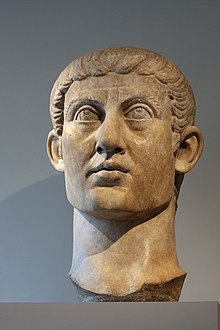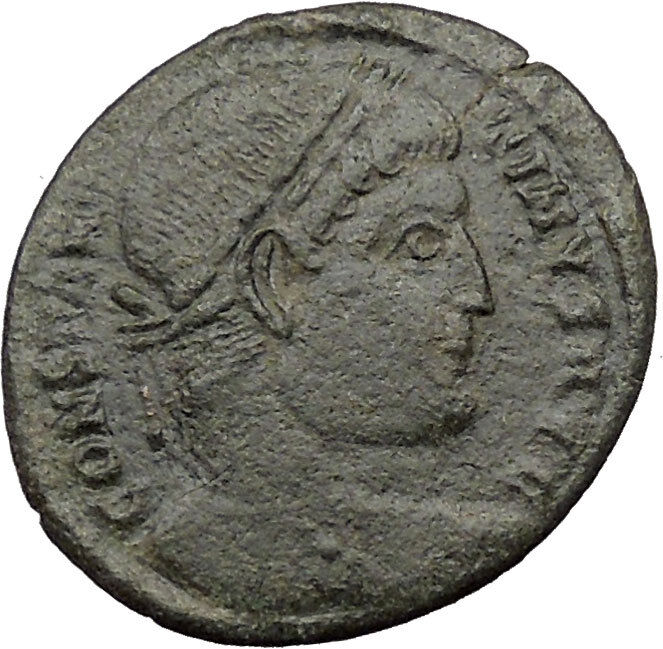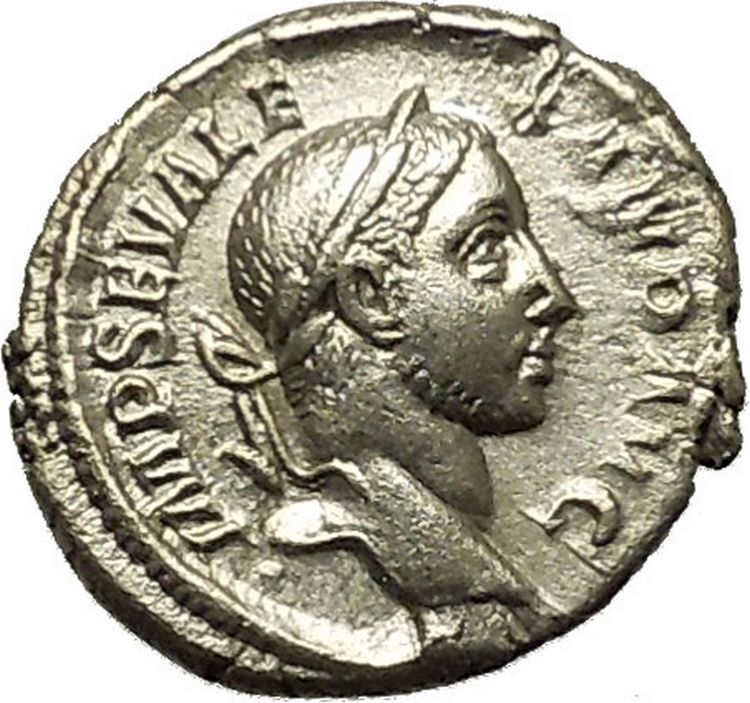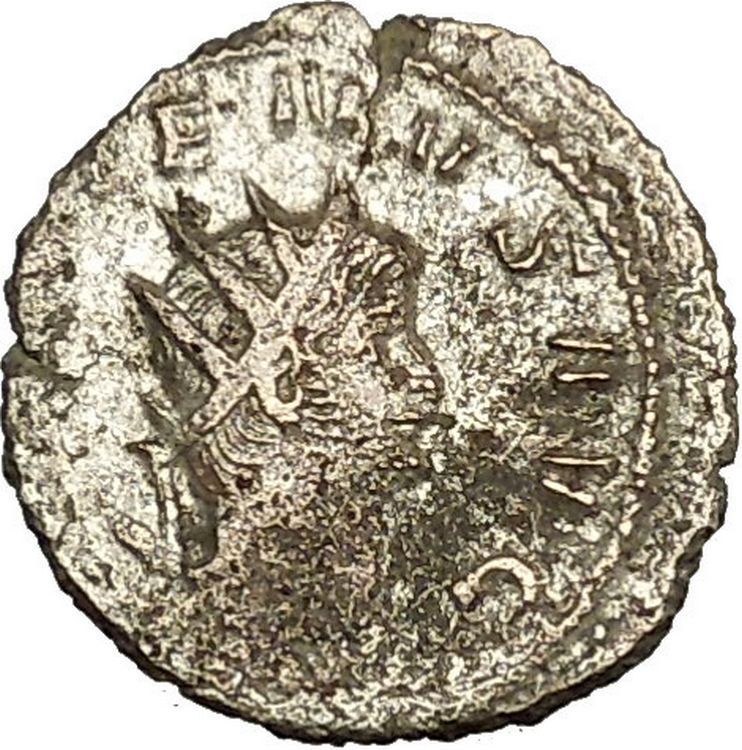|
Anonymous Issue
Founding of a new Roman Capital – Constantinople Commemorative
Bronze AE4 13mm (1.42 grams) Heraclea mint, struck circa 347-348 A.D.
CONSTANTINOPOLI, Constantinopolis helmeted, laureate bust left, holding scepter over shoulder.
VOT/XX/MVLT/XXX / within wreath, •SMHΓ below
By circa 330 A.D., Constantine the Great completed his new capital for the Roman empire and called it Constantinople after himself, originally the ancient Greek city named Byzantium. Constantinople lay in a strategically important location and could be considered the continuation of the Roman empire in the east until about 1453 A.D. when it fell to the Ottoman Turks. For this momentous occasion, he issued two coin types commemorating this event, with one celebrating Rome and the other Constantinople. The type that commemorated Rome had the personification of Rome, Roma with the inscription VRBS ROMA and the founders of Rome, Romulus and Remus on the reverse suckling the mythical she-wolf. The type that commemorated Constantinople had the personification of Constantinople on the obverse and Victory on a galley sailing with a shield. This was a great way for Constantine the Great to pay homage to both Rome and Constantinople as now the Roman empire had two official capitals.
Constantinopolis, built on the site of the ancient Byzantium by Constantine the Great, who called it after his own name and made it the capital of the Roman empire. It was solemnly consecrated A.D. 330. It was built in imitation of Rome. Thus it covered 7 hills, was divided into 14 regiones, and was adorned with various buildings in imitation of the capital of the Western world. Its extreme length was about 3 Roman miles ; and its walls included eventually a circumference of 13 or 14 Roman miles. It continued the capital of the Roman empire in the east until its capture by the Turks in 1453.
You are bidding on the exact item pictured, provided with a Certificate of Authenticity and Lifetime Guarantee of Authenticity.
Read the Constantine the Great Ancient Roman Coins Guide to learn more about his coins.
 Constantinople was the capital city of the Roman/Byzantine Empire (330-1204 and 1261-1453), and also of the brief Latin (1204-1261), and the later Ottoman (1453-1923) empires. It was reinaugurated in 324 AD from ancient Byzantium as the new capital of the Roman Empire by Emperor Constantine the Great, after whom it was named, and dedicated on 11 May 330 AD. Constantinople was the capital city of the Roman/Byzantine Empire (330-1204 and 1261-1453), and also of the brief Latin (1204-1261), and the later Ottoman (1453-1923) empires. It was reinaugurated in 324 AD from ancient Byzantium as the new capital of the Roman Empire by Emperor Constantine the Great, after whom it was named, and dedicated on 11 May 330 AD.
From the mid-5th century to the early 13th century, Constantinople was the largest and wealthiest city in Europe and it was instrumental in the advancement of Christianity during Roman and Byzantine times as the home of the Ecumenical Patriarch of Constantinople and as the guardian of Christendom’s holiest relics such as the Crown of Thorns and the True Cross. After the final loss of its provinces in the early 15th century, the Byzantine Empire was reduced to just Constantinople and its environs, along with Morea in Greece, and the city eventually fell to the Ottomans after a month-long siege in 1453.
Constantinople was famed for its massive and complex defenses. Although besieged on numerous occasions by various peoples, the defences of Constantinople proved invulnerable for nearly nine hundred years before the city was taken in 1204 by the Crusader armies of the Fourth Crusade, and after it was liberated in 1261 by the Byzantine Emperor Michael VIII Palaiologos, a second and final time in 1453 when it was conquered by the Ottoman Sultan Mehmed II. The first wall of the city was erected by Constantine I, and surrounded the city on both land and sea fronts. Later, in the 5th century, the Praetorian Prefect Anthemius under the child emperor Theodosius II undertook the construction of the Theodosian Walls, which consisted of a double wall lying about 2 km (1.2 miles) to the west of the first wall and a moat with palisades in front. This formidable complex of defences was one of the most sophisticated of Antiquity and the city was built intentionally on seven hills as well as juxtaposed between the Golden Horn and the Sea of Marmara and thus presented an impregnable fortress enclosing magnificent palaces, domes, and towers, necessitated from being the gateway between two continents (Europe and Asia) and two seas (the Mediterranean and the Black Seas).
The city was also famed for its architectural masterpieces, such as the Greek Orthodox cathedral of Hagia Sophia, which served as the seat of the Ecumenical Patriarchate, the sacred Imperial Palace where the Emperors lived, the Galata Tower, the Hippodrome, the Golden Gate of the Land Walls, and the opulent aristocratic palaces lining the arcaded avenues and squares. The University of Constantinople was founded in the fifth century and contained numerous artistic and literary treasures before it was sacked in 1204 and 1453, including its vast Imperial Library which contained the remnants of the Library of Alexandria and had over 100,000 volumes of ancient texts.
Constantinople never truly recovered from the devastation of the Fourth Crusade and the decades of misrule by the Latins. Although the city partially recovered in the early years after the restoration under the Palaiologos dynasty, the advent of the Ottomans and the subsequent loss of the Imperial territories until Constantinople became an enclave inside the fledgling Ottoman Empire rendered the city severely depopulated when it fell to the Ottoman Turks, whereafter it replaced Edirne (Adrianople) as the new capital of the Ottoman Empire.
Constantine I ‘The Great’ – Roman Emperor: 307-337 A.D.
Caesar (Recognized): 306-309 A.D. | Filius Augustorum (Recognized): 309-310 A.D. | Augustus (Self-Proclaimed): 307-310 A.D. | Augustus (Recognized): 310-337 A.D. |
| Son of Constantius I ‘Chlorus’ and Helena | Step-son of Theodora | Husband of Minervina and Fausta | Father (by Minervina) of Crispus and (by Fausta) of Constantine II, Constantius II, Constans, Constantina (wife of Hanniballianus & Constantius Gallus) and Helena the Younger (wife of Julian II) | Son-in-law of Maximian and Eutropia | Brother-in-law of Maxentius | Half-brother of Constantia (w. of Licinius I) | Half-uncle of Delmatius, Hanniballianus, Constantius Gallus, Julian II, Licinius II and Nepotian | Grandfather of Constantia (wife of Gratian) |
 Constantine the Great (Latin: Flavius Valerius Aurelius Constantinus Augustus; 27 February c. 272 AD – 22 May 337 AD), also known as Constantine I or Saint Constantine (in the Orthodox Church as Saint Constantine the Great, Equal-to-the-Apostles), was a Roman Emperor from 306 to 337 AD. Constantine was the son of Flavius Valerius Constantius, a Roman army officer, and his consort Helena. His father became Caesar, the deputy emperor in the west in 293 AD. Constantine was sent east, where he rose through the ranks to become a military tribune under the emperors Diocletian and Galerius. In 305, Constantius was raised to the rank of Augustus, senior western emperor, and Constantine was recalled west to campaign under his father in Britannia (Britain). Acclaimed as emperor by the army at Eboracum (modern-day York) after his father’s death in 306 AD, Constantine emerged victorious in a series of civil wars against the emperors Maxentius and Licinius to become sole ruler of both west and east by 324 AD. Constantine the Great (Latin: Flavius Valerius Aurelius Constantinus Augustus; 27 February c. 272 AD – 22 May 337 AD), also known as Constantine I or Saint Constantine (in the Orthodox Church as Saint Constantine the Great, Equal-to-the-Apostles), was a Roman Emperor from 306 to 337 AD. Constantine was the son of Flavius Valerius Constantius, a Roman army officer, and his consort Helena. His father became Caesar, the deputy emperor in the west in 293 AD. Constantine was sent east, where he rose through the ranks to become a military tribune under the emperors Diocletian and Galerius. In 305, Constantius was raised to the rank of Augustus, senior western emperor, and Constantine was recalled west to campaign under his father in Britannia (Britain). Acclaimed as emperor by the army at Eboracum (modern-day York) after his father’s death in 306 AD, Constantine emerged victorious in a series of civil wars against the emperors Maxentius and Licinius to become sole ruler of both west and east by 324 AD.
As emperor, Constantine enacted many administrative, financial, social, and military reforms to strengthen the empire. The government was restructured and civil and military authority separated. A new gold coin, the solidus, was introduced to combat inflation. It would become the standard for Byzantine and European currencies for more than a thousand years. The first Roman emperor to claim conversion to Christianity, Constantine played an influential role in the proclamation of the Edict of Milan in 313, which decreed tolerance for Christianity in the empire. He called the First Council of Nicaea in 325, at which the Nicene Creed was professed by Christians. In military matters, the Roman army was reorganised to consist of mobile field units and garrison soldiers capable of countering internal threats and barbarian invasions. Constantine pursued successful campaigns against the tribes on the Roman frontiers-the Franks, the Alamanni, the Goths, and the Sarmatians-even resettling territories abandoned by his predecessors during the Crisis of the Third Century.
The age of Constantine marked a distinct epoch in the history of the Roman Empire. He built a new imperial residence at Byzantium and renamed the city Constantinople after himself (the laudatory epithet of “New Rome” came later, and was never an official title). It would later become the capital of the Empire for over one thousand years; for which reason the later Eastern Empire would come to be known as the Byzantine Empire. His more immediate political legacy was that, in leaving the empire to his sons, he replaced Diocletian’s tetrarchy with the principle of dynastic succession. His reputation flourished during the lifetime of his children and centuries after his reign. The medieval church upheld him as a paragon of virtue while secular rulers invoked him as a prototype, a point of reference, and the symbol of imperial legitimacy and identity. Beginning with the Renaissance, there were more critical appraisals of his reign due to the rediscovery of anti-Constantinian sources. Critics portrayed him as a tyrant. Trends in modern and recent scholarship attempted to balance the extremes of previous scholarship.
Constantine is a significant figure in the history of Christianity. The Church of the Holy Sepulchre, built on his orders at the purported site of Jesus’ tomb in Jerusalem, became the holiest place in Christendom. The Papal claim to temporal power in the High Middle Ages was based on the supposed Donation of Constantine. He is venerated as a saint by Eastern Orthodox, Byzantine Catholics, and Anglicans.
|





 Constantinople was the capital city of the Roman/Byzantine Empire (330-1204 and 1261-1453), and also of the brief Latin (1204-1261), and the later Ottoman (1453-1923) empires. It was reinaugurated in 324 AD from ancient Byzantium as the new capital of the Roman Empire by Emperor Constantine the Great, after whom it was named, and dedicated on 11 May 330 AD.
Constantinople was the capital city of the Roman/Byzantine Empire (330-1204 and 1261-1453), and also of the brief Latin (1204-1261), and the later Ottoman (1453-1923) empires. It was reinaugurated in 324 AD from ancient Byzantium as the new capital of the Roman Empire by Emperor Constantine the Great, after whom it was named, and dedicated on 11 May 330 AD. Constantine the Great (Latin: Flavius Valerius Aurelius Constantinus Augustus; 27 February c. 272 AD – 22 May 337 AD), also known as Constantine I or Saint Constantine (in the Orthodox Church as Saint Constantine the Great, Equal-to-the-Apostles), was a Roman Emperor from 306 to 337 AD. Constantine was the son of Flavius Valerius Constantius, a Roman army officer, and his consort Helena. His father became Caesar, the deputy emperor in the west in 293 AD. Constantine was sent east, where he rose through the ranks to become a military tribune under the emperors Diocletian and Galerius. In 305, Constantius was raised to the rank of Augustus, senior western emperor, and Constantine was recalled west to campaign under his father in Britannia (Britain). Acclaimed as emperor by the army at Eboracum (modern-day York) after his father’s death in 306 AD, Constantine emerged victorious in a series of civil wars against the emperors Maxentius and Licinius to become sole ruler of both west and east by 324 AD.
Constantine the Great (Latin: Flavius Valerius Aurelius Constantinus Augustus; 27 February c. 272 AD – 22 May 337 AD), also known as Constantine I or Saint Constantine (in the Orthodox Church as Saint Constantine the Great, Equal-to-the-Apostles), was a Roman Emperor from 306 to 337 AD. Constantine was the son of Flavius Valerius Constantius, a Roman army officer, and his consort Helena. His father became Caesar, the deputy emperor in the west in 293 AD. Constantine was sent east, where he rose through the ranks to become a military tribune under the emperors Diocletian and Galerius. In 305, Constantius was raised to the rank of Augustus, senior western emperor, and Constantine was recalled west to campaign under his father in Britannia (Britain). Acclaimed as emperor by the army at Eboracum (modern-day York) after his father’s death in 306 AD, Constantine emerged victorious in a series of civil wars against the emperors Maxentius and Licinius to become sole ruler of both west and east by 324 AD.




